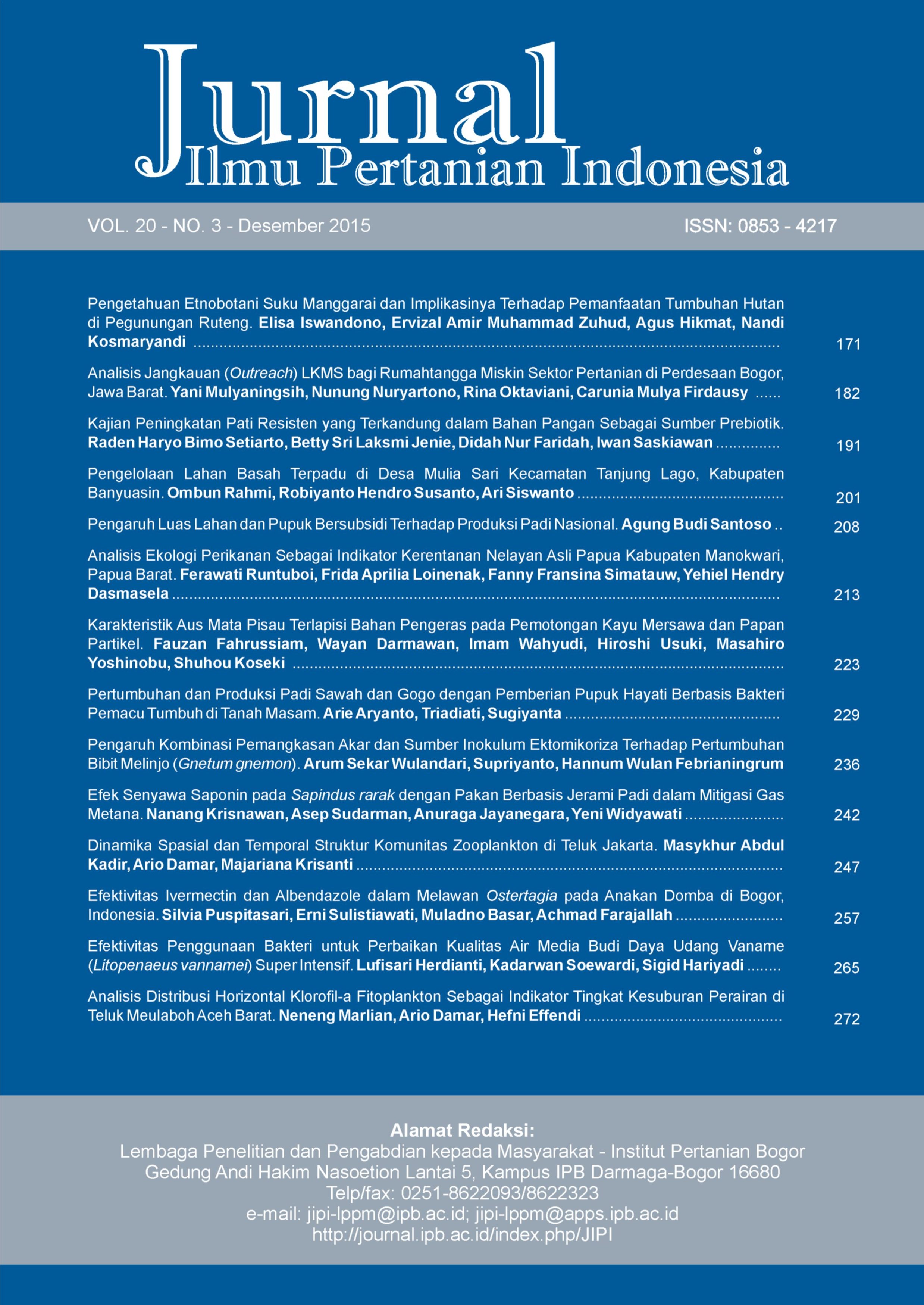Dinamika Spasial dan Temporal Struktur Komunitas Zooplankton di Teluk Jakarta
Abstract
Study of spatial and temporal dynamics of zooplankton community structure in the Jakarta Bay. The purpose are analyzing the abundance, distribution, diversity, and dominance index with indicators of water quality spatial and temporal waters of Jakarta Bay. The research was conducted from July-October 2013. Sampling was done four times (July, August, September, and October). The water quality was analysed by Laboratory Productivity and Water Environment at Department of Resources Management, Faculty of Fisheries and Marine Sciences, Bogor Agricultural University. Zooplankton were analyzed using the method of enumeration (census SRC), in Micro Biology Laboratory Faculty. Based on the distribution patterns were its indicates that the landward dissolved oxygen (DO) is increasingly high, especially in August, September, and October, and increase the abundance of zooplankton as much as 1.3106 Ind/m3. DO with a high spatial concentration value reaches the range of 6.2-14.5 mg/L in Muara Marunda (Station 10), and increase the abundance of zooplankton as much as 5.1106 Ind/m3, with a majority composition of crustacea. Results of classification was diversity moderate, stable uniformity, and high dominance index.Downloads
References
Anonymous. 1999. The Monitoring of Jakarta Bay, Office of City and Environment Studies, government of Jakarta City. 126 pp.
[APHA] American Public Health Association. 2005. Standard Methods for The Examination of Water and Wastewater. 21th Edition. Washington DC (US): American Public Health Assosiation American Water Work Association/Water Enviroment Federation.
[APHA] American Public Health Association. 2012. Standard Methods for The Examination of Water and Wastewater. 22nd edition. Washington DC (US): American Public Health Association.
Boyer JN, Kelble CR, Ortner PB, Rudnick DT. 2009. Phytoplankton bloom status: Chlorophyll a biomass as an indicator of water quality condition in the southern estuaries of Florida, USA. Ecological Indicators. 9(6): S56-S67. http://doi.org/d5qv3k
Cass CJ, Daly KL. 2014. Eucalanoid copepod metabolic rates in the oxygen minimum zone of the eastern tropical north Pacific: Effects of oxygen and temperature. Deep-Sea Research I. 94: 137-149. http://doi.org/8h5
Damar A. 2003. Effect of Enrichment on Nutrient Dynamics, Phytoplankton Dynamics and Productivity in Indonesias Tropical Waters: a Comparison between Jakarta bay, Lampung bay, and Samangka bay. [Disertation]. Kiel (DE): University of Kiel.
Damar A, Colijn F, Hesse K-J, Wardiatno Y. 2012. The eutrophication states of Jakarta, Lampung and Semangka Bays: Nutrient and phytoplankton dynamics in Indonesian tropical waters. Journal of Tropical Biology & Conservation. 9(1): 61-81.
Damar A, Vitner Y, Palmirmo P, Kadir MS. 2013. Deteksi Faktor Lingkungan Pemicu Timbulnya Peledakan Populasi Fitoplankton (RED TIDE) di Perairan Teluk Jakarta dan Kaitannya dengan Eutrofikasi Perairan Pesisir dan Laut. Laporan penelitian BOPTN Dikti.
Dahuri R, Putra SN, Zairon, Sulistiono. 1993. Metode dan Teknik Analisis Biota Perairan. Bogor (ID): PPLH-LP Institut Pertanian Bogor.
Dugdale RC, Wilkerson FP, Hogue VE, Marchi A. 2007. The role of ammonium and nitrate in spring bloom development in San Francisco Bay. Estuarine, Coastal and Shelf Science. 73(1-2): 17-29. http://doi.org/cgbtmz
Effendi H. 2003. Telaah Kualitas Air bagi pengelolaan sumber daya lingkungan perairan. Yogyakarta (ID): Penerbit Kanisius (Anggota IKAPI).
Jerling HL. 2003. The zooplankton community of the Mhlathuze (Richard Bay) estuary: two decades after construction of the harbour. African Journal of Marine Science. 25: 289-299. http://doi.org/fgjj84
Lee CD, Wang SB, Kuo CL. 1978. Benthic Macroinvertebrate and Fish as Biological Indicator of Water Quality With Reference to Community Diversity Development Countries. Bangkok (TH).
Odum EP. 1971. Fundamental of Ecology. Tokyo (JP): W.B.Sunders, Toppan Co.Ltd.
Palmirmo F. 2013. Dinamika sebaran bakteri Heterotrofik, Nutrien dan Fitoplankton di Perairan Teluk Jakarta. Pengelolaan Sumber Daya Perairan. Institut Pertanian Bogor (IPB).
Pepin P, Colbourne EB, Maillet G. 2011. Seasonal patterns in zooplankton community structure on the Newfoundland and Labrador Shelf. Fisheries and Oceans Canada. Progress In Oceanography. 91(3): 273-285. http://doi.org/cndvw5
[PPRI] Peraturan Pemerintah Republik Indonesia No 82 Tahun 2001. Tentang Pengelolaan Kualitas Air dan Pengendalian Pencemaran Air.
Rice E, Stewart G. 2013. Analysis of interdecadal trends in chlorophyll and temperature in the Central Basin of Long Island Sound. Estuarine, Coastal and Shelf Science. 128: 64-75. http://doi.org/8h6
Somoue L, Elkhiati N, Ramdani M, Hoai T, Ettahiri O, Berraho A, Chi TD. 2005. Abundance and structure of copepod communities along the Atlantic coast of southern Morocco. Acta Adriatica. 46(1): 63-76.
Tuner JT, Tester PA, Linciln JA, Carlsson P, Graneli E. 1999. Effects of N:P:Si ratios and zooplankton grazing on phytoplankton communities in the northern Adreatic Sea. III. Zooplankton populations and Grazing. Aquatic Microbial Ecology. 18(1): 67-75. http://doi.org/dqtvfb
Tafangenyasha C, Dzinomwa T. 2005. Land-use Impacts on River Water Quality in Lowveld Sand River Systems in South-East Zimbabwe. Land Use and Water Resources Research. 5: 3.1-3.10.
Yang CS, Kao SP, Lee FB, Hung PS. 2013. Twelve Different Interpolation Methods: A Case Study of Surfer 8,0. Proceedings of the XXth ISPRS Congress. Vol. 35: Chicago (US): National Chung Hsing University.
Zhang L, Wang Lu, Yin K, Lü Y, Zhang D, Yang Y, Huang X. 2013. Pore water nutrient characteristics and the fluxes across the sediment in the Pearl River estuary and adjacent waters, China. Estuarine, Coastal and Shelf Science. 133: 182-192. http://doi.org/8h7
This journal is published under the terms of the Creative Commons Attribution-NonCommercial 4.0 International License. Authors who publish with this journal agree to the following terms: Authors retain copyright and grant the journal right of first publication with the work simultaneously licensed under a Creative Commons Attribution-NonCommercial 4.0 International License. Attribution — You must give appropriate credit, provide a link to the license, and indicate if changes were made. You may do so in any reasonable manner, but not in any way that suggests the licensor endorses you or your use. NonCommercial — You may not use the material for commercial purposes.






















